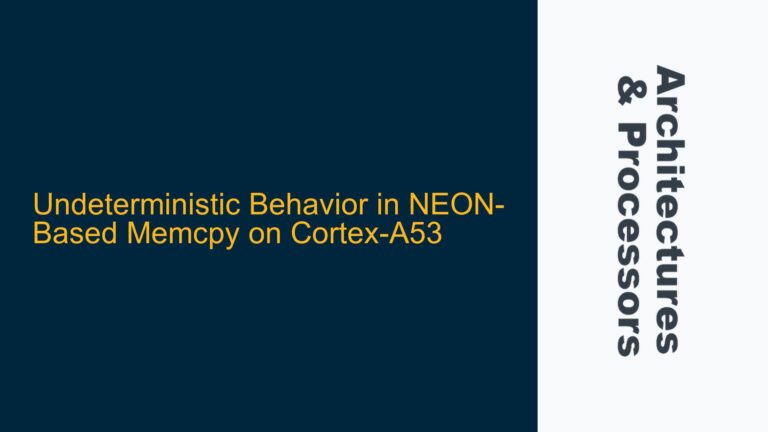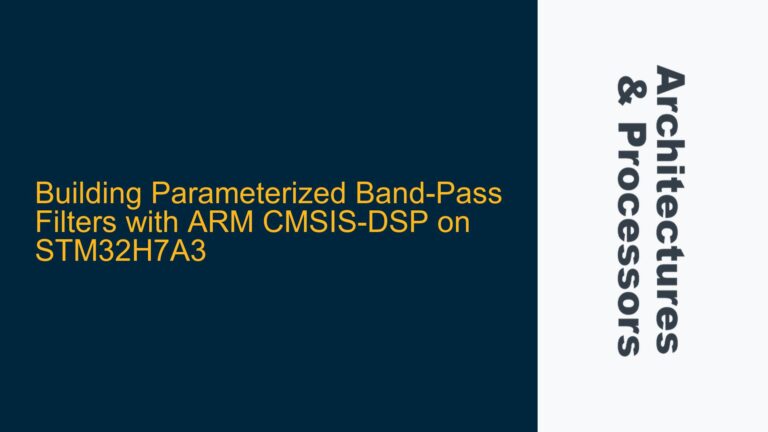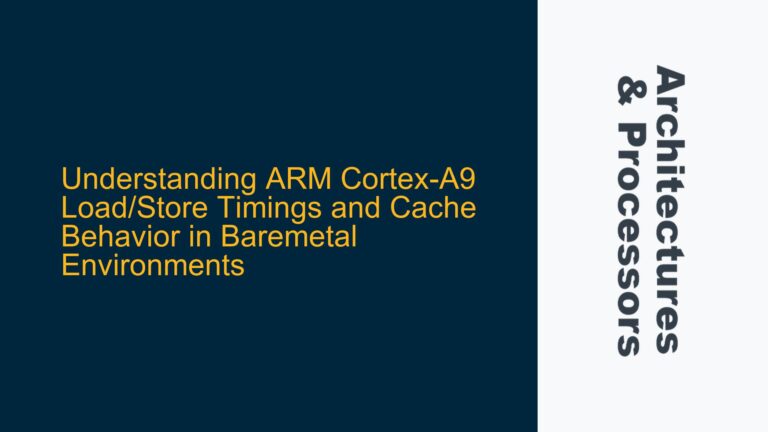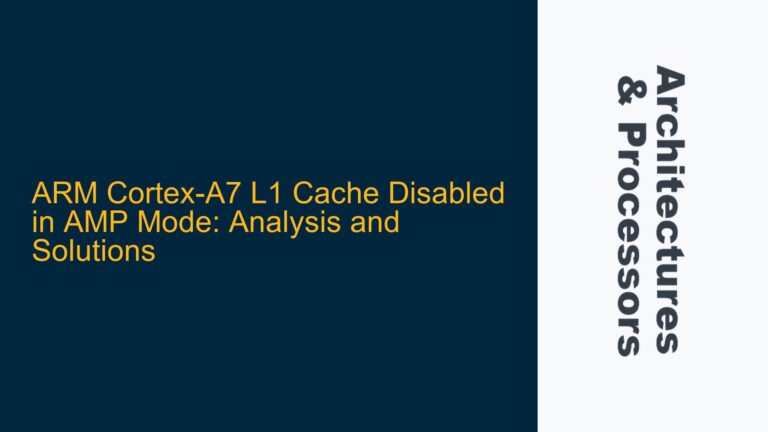ARM Cortex-A53 ELF to HEX Conversion with Unnecessary Zero Padding
When converting an ELF (Executable and Linkable Format) file to a HEX file for an ARM Cortex-A53 processor, the resulting HEX file size can become excessively large, often reaching tens of megabytes. This issue typically arises due to the inclusion of large sections of zero padding in the HEX file, which are not present in the original ELF file. The primary cause of this problem lies in the memory layout and section definitions within the linker script, particularly when dealing with the .data section and the use of the AT keyword. The AT keyword is used to specify the load memory address (LMA) of a section, which is distinct from its virtual memory address (VMA). Misuse of this keyword can lead to incorrect memory mappings, resulting in the HEX file containing large gaps filled with zeros.
The linker script provided in the discussion defines multiple memory regions, including rom, heap, and ram, and assigns sections such as .text, .heap, and .data to these regions. The .data section is particularly problematic because it uses the AT keyword to specify its load address, but the syntax is incorrect. The AT keyword should be used to define a distinct LMA for the .data section, but in this case, it is incorrectly set to _sdata, which tracks the VMA rather than the LMA. This misconfiguration causes the linker to generate a HEX file that includes all the memory gaps between sections, resulting in a file that is much larger than necessary.
Incorrect Use of AT Keyword and Memory Alignment in Linker Script
The root cause of the excessively large HEX file lies in the incorrect use of the AT keyword in the linker script. The AT keyword is used to specify the load memory address (LMA) of a section, which is the address where the section will be loaded into memory at runtime. The virtual memory address (VMA) is the address where the section will be executed. In the provided linker script, the .data section is defined as follows:
.data : AT (_sdata) {
. = ALIGN(4);
_sdata = .;
*(.data)
*(.data*)
} > ram
Here, the AT (_sdata) directive is intended to set the LMA of the .data section to _sdata. However, _sdata is a symbol that tracks the VMA of the section, not the LMA. This means that the LMA and VMA of the .data section are effectively the same, which is not the intended behavior. The correct usage of the AT keyword should specify a distinct LMA for the .data section, typically in a different memory region such as rom.
Additionally, the memory alignment directive . = ALIGN(4); is used to ensure that the section is aligned to a 4-byte boundary. While this is generally good practice, it can also contribute to the size of the HEX file if the alignment creates gaps between sections. These gaps are filled with zeros in the HEX file, further increasing its size.
Another issue is the memory layout defined in the linker script. The script defines multiple memory regions, including rom, heap, and ram, but the regions are not contiguous. This means that there are large gaps between the regions, which are also filled with zeros in the HEX file. For example, the rom region starts at address 0x00000000 and has a length of 0x3FFFF, while the heap region starts at 0x02001000. The gap between these regions is filled with zeros in the HEX file, contributing to its large size.
Correcting Linker Script and Optimizing HEX File Generation
To resolve the issue of the excessively large HEX file, the linker script must be corrected to properly define the LMA and VMA of the .data section and to ensure that memory regions are contiguous. The following steps outline the necessary changes and optimizations:
- Correct Use of the AT Keyword: The
ATkeyword should be used to specify a distinct LMA for the.datasection. The LMA should be in a different memory region, such asrom, while the VMA should be in theramregion. The corrected linker script should look like this:
.data : AT (ADDR(.text) + SIZEOF(.text)) {
. = ALIGN(4);
_sdata = .;
*(.data)
*(.data*)
} > ram
In this corrected script, the LMA of the .data section is set to the end of the .text section in the rom region, while the VMA is set to the ram region. This ensures that the .data section is loaded into rom but executed in ram.
- Contiguous Memory Regions: The memory regions defined in the linker script should be contiguous to avoid large gaps filled with zeros. The
romandramregions should be defined such that there is no gap between them. For example:
MEMORY {
rom (rx) : ORIGIN = 0x00000000, LENGTH = 0x3FFFF
ram (rw) : ORIGIN = 0x00040000, LENGTH = 0x1FFFF
}
In this example, the ram region starts immediately after the rom region, ensuring that there are no gaps between the regions.
- Optimizing HEX File Generation: The
objcopyutility can be used to generate a binary file from the ELF file, which can then be converted to a HEX file. Theobjcopyutility should be used with the-O binaryoption to generate a binary file that contains only the necessary data, without the zero padding. The following command can be used:
arm-none-eabi-objcopy -O binary input.elf output.bin
The resulting binary file can then be converted to a HEX file using a tool such as srec_cat:
srec_cat output.bin -binary -o output.hex -intel
This process ensures that the HEX file contains only the necessary data, without the unnecessary zero padding.
- Runtime Data Copying: If the
.datasection is loaded intorombut needs to be executed inram, a runtime copying mechanism must be implemented. This can be done by adding a piece of code to the.textsection that copies the.datasection from its load address (LMA) to its virtual address (VMA). The following code snippet demonstrates this:
extern uint32_t _sdata;
extern uint32_t _edata;
extern uint32_t _sidata;
void copy_data_section() {
uint32_t *src = &_sidata;
uint32_t *dst = &_sdata;
while (dst < &_edata) {
*dst++ = *src++;
}
}
This code should be called at the beginning of the main function to ensure that the .data section is copied to the correct location before it is accessed.
By following these steps, the linker script can be corrected to avoid the generation of an excessively large HEX file. The proper use of the AT keyword, contiguous memory regions, and optimized HEX file generation will result in a much smaller HEX file that contains only the necessary data, without the unnecessary zero padding. Additionally, the runtime copying mechanism ensures that the .data section is correctly loaded and executed in the appropriate memory region.
Conclusion
The issue of an excessively large HEX file generated from an ELF file for an ARM Cortex-A53 processor is primarily caused by the incorrect use of the AT keyword in the linker script and the presence of large gaps between memory regions. By correcting the linker script to properly define the LMA and VMA of the .data section, ensuring contiguous memory regions, and optimizing the HEX file generation process, the size of the HEX file can be significantly reduced. Additionally, implementing a runtime copying mechanism ensures that the .data section is correctly loaded and executed in the appropriate memory region. These steps provide a comprehensive solution to the problem, resulting in a more efficient and manageable HEX file for embedded systems development.






